"Silver Shirts for Reagan!": Walter Huss and the American "conservative" tradition with roots in 1930s-era fascism
The political world view of Walter Huss (1918-2006) was formed by the pro-Hitler, fascist organizations that flourished in late 1930s Portland...here's why that matters.
A rare antisemitic tract from the late 1930s that had been sold and circulated at Silver Shirt, German-American Bund, and American Defenders meetings in Portland in 1937-9. Walter Huss was the owner of this tract which he kept in a folder labeled “Jews Holocaust.” 99% of the contents of Huss’s archive dates from after 1960, thus making this 1937 publication unusual. How significant is it that Huss kept this particular item from his youth? Walter Huss Papers, University of Oregon Special Collections, Box 2.
An eyewitness account of a 1939 Silver Shirt meeting in Portland at which that Canadian publication in Huss’s “Jews” folder was offered for sale. George Rennar Papers, Oregon Historical Society.
How did the chair of the Oregon Republican Party ca. 1978-9 come to be the owner of a rare, Canadian antisemitic tract from the late 1930s? I think I’ve assembled enough circumstantial evidence to plausibly claim that Walter Huss acquired this very niche and (as far as I know) never-reprinted, pro-Hitler tract at a meeting of one of the several fascist organizations that was active in Portland ca. 1937-1941. Huss was born in 1918, so he was in his late teens and early twenties in the politically-charged years before WWII when a few thousand of Huss’s fellow white, Christian Portlanders attended meetings of anti-communist and pro-Hitler (or at least Hitler-accepting) groups like the Silver Shirts, the German-American Bund, and the American Defenders. I’ve got more evidence tying Huss to the Portland fascists of the 1930s that I’ll share at the end of this post, but for now I just want to crow a bit about the fact that I think I’ve found “The Key to the Mystery” (if you will) as to why Republican “conservative” activist (and 1976 and 1980 Reagan delegate to the RNC) Walter Huss often looked and sounded like such an anachronistic weirdo to his contemporaries in the 1960s, 70s, 80s, and 90s. It’s because his world view for his entire life was essentially that of an obsessively antisemitic, 1939 vintage, Portland fascist who believed Communism was a Jewish conspiracy. And when one believes that “Communism is Jewish” as Huss and the Nazis did, then the ultimate solution to the Communist problem would seem to follow logically…and genocidally…from that starting, false premise.
A copy of Walter Huss’s Portland Newspaper from June 24, 1965 that was digitized as part of the Hall-Hoag Collection at Brown University. The “Communism is Jewish” stamp belonged to Joseph Dilys who offered Huss’s paper for sale at his kiosk in Chicago. Dilys was Chicago’s most notorious neo-Nazi and public vendor of fascist propaganda from the 1960s into the 1990s. I have yet to discover how Dilys came to know about Huss’s newspaper, but the fact that Dilys regarded Huss as a fellow traveler is notable.
Throughout his career as a public figure in Oregon (1960-2000), almost no one in the state’s media or politics used the “f-word” to describe Huss. He was usually categorized as “an ultraconservative,” “a charismatic preacher with traditionalist social views,” “a kook,” or, on a few occasions, “hate-monger.” In 1978, when former President Gerald Ford inquired with a Republican friend in Oregon as to whether they’d managed to oust Huss from the GOP chairmanship yet, Ford referred to Huss as “that nut.” Soon after being elected chair of the OR GOP in 1978, Huss gave an interview in which he made an off-hand reference to Portland’s “Jewish-controlled press.” That fascistic phrase raised a few eyebrows, but still, no media outlet at the time explicitly said “that’s how Hitler used to talk about the press!”
Since WWII, Americans have rarely used the term “fascist” to describe other Americans because it has generally been thought of as a content-free epithet, a mean-spirited amplifier that translates as “I really dislike that person’s politics.” There has also been the widespread, but erroneous, assumption that fascist movements happened in other countries in the 1930s but not here in America. After all, we’re the ones who defeated fascism!
To be sure, there were and are good reasons to be parsimonious with the use of the noun “fascist” or the adjective “fascistic” to describe our fellow citizens. But in this case, I feel quite confident saying that Walter Huss’s world view was “fascistic,” even if he always kept some plausibly deniable distance between himself and the more overt “fascists” in the Pacific Northwest, many of whom were Huss’s longtime friends, who plotted and engaged in acts of violence intended to bring about political change. I’ve written more about Huss’s complicated relationship to right wing political violence in the post linked below.
Walter Huss and the Fascist Fifth Column in Cold War America
The more I’ve learned about the broader political milieu of which Walter Huss was a part, the more I’ve come to think of him as an enthusiastic if minor player in an aspiring fascist Fifth Column in Cold War America. This fragmented movement was allied with the more mainstream conservative movement in its staunch opposition to communism and liberalism, …
Huss’s foundational, 1930s era assumption that Communism was a Jewish conspiracy remained constant throughout his life, but the content of that violently white nationalist and conspiratorial, antisemitic world view evolved over time. While he first encountered these ideas as a young man in Portland the late 1930s, they were solidified in the late 1940s when Huss trained for the Foursquare ministry at a Los Angeles church where Gerald LK Smith, Wesley Swift, and other fascistic Christian Nationalists frequently preached. In 1963, 1967, and 1970 Huss took a close associate of those same Christian Identity preachers, Kenneth Goff, on week-long speaking tours throughout the Pacific Northwest. Goff ran a training camp for right wing domestic terrorists in Colorado, and it’s hard to believe that this never came up as he and Huss drove hundreds of miles from one speaking gig to the next. Throughout the 1980s Huss was on the mailing lists of neo-Nazi organizations like the Sons of Liberty (run by James K. Warner in Louisiana), the Institute for Historical Review (Holocaust denialism), and David Duke’s National Association for the Advancement of White People. For much of his life Huss subscribed to Gerald LK Smith’s antisemitic magazine The Cross and the Flag, and in the 1970s and 80s he received (and kept in his files) newsletters from militia-linked Christian Identity figures like Jack Mohr and Sheldon Emry. In the mid-1990s, when he 75 years old, Huss attended multi-day survivalist training sessions run by Bo Gritz where he listened to (and recorded!) lectures by Eustace Mullins, an old-school antisemite from the WWII era who was Ezra Pound’s leading American disciple.
I could go on, but you get the idea. Huss’s brain was pickled in some of the furthest right, most violently antisemitic, fascistic reading material available to him from the late 1930s when the preferred boogeyman was “the Jew Deal,” into the 1990s when the Judeo-Bolshevist “enemy” manifested in forms like the “ZOG (Zionist Occupation Government).”
Undated newsletter (probably 1987-8 judging by context clues) in Walter Huss’s “Jews Holocaust” folder. Walter Huss Papers, University of Oregon Special Collections, Box 2.
Huss was hardly the only fascist in Cold War America, but what makes him especially noteworthy is that in 1960 he made it his life’s mission to remake the Oregon Republican Party into a vehicle for advancing the illiberal goals of the fascistic, pre-WWII “America First” movement into which he’d been socialized. Huss’s Silver Shirt-inflected political project sought to eliminate the imaginary “Jewish/Communist conspiracy” that he genuinely believed was responsible for all of America’s social, political, and economic ills and was on the cusp of destroying the nation. [Spoiler alert: between the late 1930s and Huss’s death in 2006, the nation was NOT destroyed.] By working to expose and eliminate “the Jewish mafia” that supposedly controlled the media, the schools, and the government—and which even cowed into submission most of the nation’s other white Christians who should have known better—Huss hoped that his anti-liberal version of the GOP could finally restore America to the white Christian nation it had supposedly been founded as and which God had always intended it to be. This was the fascistic telos toward which Huss’s version of “conservative Republicanism” was oriented. And this is why it’s so stunning that the person who submitted the paragraph below to a court of law in 1986 had succeeded in getting elected chair of the historically-moderate OR GOP only 8 years earlier.
An excerpt of a legal brief that Walter Huss filed in 1986 explaining why the fine he received for illegally importing Brazilian bark tea that he falsely claimed cured cancer was actually just part of the Jewish Mafia’s vendetta against Huss for being such an effective anti-Communist for so many years. Walter Huss Papers, University of Oregon, Box 13.
Even though he occasionally voiced his antisemitic “truths” in written statements like this, Huss was usually savvy enough to know that he was likely to meet with resistance if he spoke to the Cold War-era American public in openly Hitleresque, fascist terms about the existential Jewish/Communist threat to White Christian America that bog-standard, Cold War liberalism supposedly posed. That is why he largely avoided speaking to the mainstream press and why he didn’t even try to work collaboratively with the relatively moderate business conservatives who were the power brokers in the OR GOP in the 1960s and 70s. One honest conversation between Huss and the politically pragmatic funders of the OR GOP would have made it apparent why someone like him should never get anywhere near the levers of power or the communication outlets of a party that hoped to ever be electorally viable in a post-WWII America that, at least nominally, thought of itself as a non-fascist, religiously pluralistic, multi-racial democracy.
We can see this dynamic at work in the dismissive way Mark Hatfield treated Huss as his opponent in the 1966 OR GOP primary for US Senate. Hatfield had served as Governor for eight years and was clearly the front runner in the race. That said, it was a two-person primary and Huss was a well known public figure in the state. Huss had run in the GOP primary for the 3rd Congressional District in 1962 and made a respectable showing even though he lost. He published a newspaper in Portland and could be heard 5 days a week on the radio in most localities around the state. He was not some random, unknown challenger. And Hatfield was exactly the sort of corny “believer in American democracy” who would have valued the open airing of political differences in a primary campaign so as to enable the public to make a fully-informed decision. And yet Hatfield, in his first run for US Senate, simply refused to treat Huss as a legitimate political opponent. Did he do this because he knew Huss was a fascist?
Huss challenged Hatfield to a debate in the week before the election, and as you can see, Hatfield’s staffers treated it like a joke.
From the “Walter Huss” file in the Mark Hatfield Papers, Willamette University Archives.
The screenshot below is from Hatfield’s 900-page, 1998 Oral History conducted by the Oregon Historical Society. This is the only time in that entire interview that Hatfield mentioned Huss—a surprising degree of silence about the man who arguably did more than anyone else to turn Hatfield’s Oregon Republican party into the fever swamp of far right conspiracy theories that Hatfield himself frequently lamented in the last two decades of his life.
It’s notable that Hatfield remembers Huss going on and on about “the Republican Party this or the Republican Party that” in 1966. Huss was laser-focused on shifting the Republican party as an institution and as a brand in the direction of his far right political vision, while Hatfield was a much less ideological and more pragmatic politician who was interested in winning elections and crafting legislation he thought would benefit the state and the country. Hatfield was indeed a very popular politician in Oregon from the 1950s into the 1990s, and because of his appeal to independent and moderate Democratic voters, he didn’t really need the support of the Oregon Republican Party to win elections after his first Senate victory in 1966. The fact that Hatfield so egregiously misremembered the date of Huss’s pivotal victory as OR GOP chair (it was 1978, not 1966) speaks to just how uninvolved Hatfield was in the internal workings of the OR GOP. The moderates’ inattention to what was happening in the Republican grassroots in the late 1960s and early 1970s played a significant role in enabling a fascist like Huss to swoop in and steal the party out from under them.
Huss’s 1978 victory as OR GOP chair was so stunning that the Washington Post ran a story on it. It was not every day that something as pedestrian as the election of a party chair in a relatively small state merited a WaPo write up. The last three paragraphs of that 1978 story stand out in hindsight. As one of Oregon’s moderate Republicans, Norma Paulus, pointed out at the time, Huss’s populist, anti-government appeal to previously marginalized conservative evangelicals “could be a lot of trouble” for the sort of modern Republican Party she envisioned. If only Paulus could have seen what was coming down the pike.
In an age when we find ourselves talking a lot about the threat of Christian Nationalism, that last 1978 quote from Huss hits especially hard.
Returning to 1966, there’s no doubt that as a short-term political calculation, Hatfield’s decision to shoo Huss away like an annoying fly worked like a charm. Hatfield won the Senate primary with 178,000 votes to Huss’s 31,000. Huss, of course, thought the “psycho-political warfare” that “the managed press” had waged on the Oregon electorate was the main cause for his loss. Here’s how Huss described the liberal media’s supposed, pro-Hatfield “propaganda campaign” in the National Eagle, an overtly propagandistic monthly paper that Huss published as an antidote to what he called (in private) “the Jewish-controlled press.”
I have yet to find any sources that provide insight into why Hatfield’s campaign decided to mostly ignore Huss. Some of it was undoubtedly class and educational snobbery directed at a poorly-educated outsider with a predominantly lower-middle class and rural base of supporters. I suspect, however, that some of Hatfield’s refusal to treat Huss like a legitimate political opponent also derived from an instinctive sense that Huss’s movement had more than a whiff of the gas chamber about it. When the Holocaust-denying Huss took over the reigns of the OR GOP in 1978, it had been only 33 years since those gas chambers had claimed their last victim. A good number of Hatfield’s staffers in 1966 had, like Hatfield, served in WWII and knew all too well what fascism looked like and resulted in. That said, the fact that neither Hatfield nor any of his contemporaries used “the f-word” to describe Huss in 1966 or 1978 suggests that it seemed inconceivable to them that an American (and WWII vet to boot!) who aspired to be the chair of the Oregon Republican Party could really, truly believe the fascistic things that Huss believed…and yet Huss’s two thick folders labeled “Jews” and his mailing lists filled with the names of tens of thousands of Oregonians who worked with him on political campaigns over the years, makes clear that it was indeed quite possible.
This is the back page of a June 1973 newsletter entitled “Christian Advocate” which Huss kept in his Jews folder. The lead article was “A Real Case Against the Jews.”
Information Walter Huss requested in 1983 from the Institute for Historical Review, the leading outlet of Holocaust denialism.
Hatfield’s response to Huss reminds me of the moment right after Trump’s inaugural address when George W Bush turned to Hilary Clinton and said “that was some weird shit.” My sense is that this was exactly what most establishment Oregon Republicans thought whenever they listened to Walter Huss speak for any length of time. American politics has long been marked by all sorts of “weird shit” over the years…but sometimes that “weird shit” could be more accurately described as “fascistic shit,” and it might benefit us as a nation if we got more comfortable dropping the vague language.
Why does it matter if Huss was a Silver Shirt?
The Silver Shirt provenance of Huss’s brand of “anti-communist conservatism” helps us make sense of why his contemporaries used analytically imprecise words like “weird” or “kook” or “crackpot” to describe him. He seemed like a man out of time in the post-WWII era when he built a grassroots insurgency that eventually took over the OR GOP, because in many ways he WAS a man out of time. His seemingly mainstream anti-communism and socially conservative evangelicalism made him recognizable to his contemporaries as a “normal” participant in American politics. That said, the fascistic inflection of his anti-communism and Christian Identity beliefs, which he didn’t always have the savvy to effectively hide, also made him sound strange to the majority of his fellow citizens, Republican and Democrat, who were unfamiliar with the explicitly white supremacist and antisemitic conspiracy theory that provided the interpretive lens through which Huss made sense of every aspect of the world around him. "We're concerned that the civil rights movement is trying to bring about change too rapidly and in the wrong way" was a conservative message that frequently appeared in the mainstream media of the 1960s. Huss's belief that ‘MLK, Jr. was a Communist stooge who was being used by his Jewish puppet masters as part of their globalist, Satanic plot to destroy Christianity and American civilization’ was considered beyond the pale by most establishment politicians and institutions, but not necessarily by the sort of rank and file conservatives who Huss worked to organize into a populist insurgency that sought to remake "conservatism" and the Republican Party in its own image.
In the age of Trump there’s been an understandable urge on the part of some folks on the left to retcon the history of American conservatism, to make it all seem like an inevitable run-up to January 6 and our current moment. ‘They were always fascists.’ This oversimplification is basically the mirror image of the naive, ca. 2016-17 Never Trumper impulse to say “how the heck did this happen? This is not who we are!” The story of how a 1930s era fascist like Walter Huss led a grassroots, far right insurgency that eventually took over the political culture of the once moderate OR GOP enables us to tell a history of the American right in which the fascist tradition is neither “what the US right has always been,” nor a completely absent category of analysis.
Huss’s election as OR GOP chair in 1978 was the culmination of over a decade of concerted effort. He and his grassroots foot soldiers had been present at every single GOP convention since 1968, just as the Trumpian elements of the GOP that triumphed in 2016 had been evident in Michele Bachmann’s 2012 campaign, the Tea Party of 2009-10, Sarah Palin in 2008, the “Buchanan brigades” before them, and on and on. The fascistic politics of racial resentment, Christian nationalism, anti-immigrant bile, and anti-government/anti-expert populism—what Chip Berlet and Matthew Lyons in 2000 called “right wing producerism”—has long been a feature on the American political landscape, though it has never been the dominant messaging of only one political party the way it is today.
Figure from Chip Berlet and Matthew Lyons, Right Wing Populism in America: Too Close for Comfort (2000).
Huss’s story is fairly unusual in that he occupied all three boxes on that graphic, He had personal ties to a good number of the insurgents in the Posse Comitatus, Christian Identity, Aryan Nations, and Neo-nazis organizations named in the box on the far right. His entire life’s work from 1960 on was devoted to traveling to every county in Oregon organizing the diverse community of repressive right wing populists named in the center circle. And as someone who attended the 1976 and 1980 GOP convention as a Reagan delegate, who attended RNC meetings in DC in 1979 where he met with numerous Republican Senators and representatives, and who was arguably one of Oregon’s most effective “conservative” activists for much of the 1960s and 1970s, Huss very much stood out as a representative figure from the box on the left. Huss was precisely the sort of “apple pie fascist “ (to borrow historian Richard Steigmann-Gall’s useful phrase) who could move across all three of those worlds, though his fascism frequently met with at least some resistance when he tried to operate on the landscape of mainstream American politics.
Although Walter Huss may have been a man out of his time in the 1970s and 80s, it would appear that perhaps his time has returned as the Trumpian Republican Party embraces a more openly authoritarian, illiberal, bizarrely conspiratorial, nationalistic, and theocratic style of politics that resembles Huss’s vision for the Republican Party ca. 1978 far more than it reflects the values of the elected Republicans of his day like Mark Hatfield. Should Donald Trump win in 2024 and implement Project 2025, it might accelerate the dismantling of the New Deal Order (which Huss and his cohort in the 1930s referred to as “the Jew Deal”) and usher in some new, post-New Deal form of authoritarian federalism that is a genealogical descendant of the fascist, Christian Nationalist tradition into which Walter Huss was socialized in the 1930s and which animated his political activism his entire life.
Every time Donald Trump describes his “enemies” as “Communists” or refers to “un-American” civil rights organizations like BLM, “dangerous” religious minorities like Muslims, media outlets who are “the enemy of the people,” or “anti-Christian, God-hating radical left Democrats” like Joe Biden (lol), he’s speaking a fascistic, conspiratorial language of us and them, good and evil, that would have been very familiar to Walter Huss. It strikes me as not coincidental, for instance, that one of the earliest proposals I’ve ever seen for building an enormous, sadistic wall across the entire border with Mexico was floated in 1965 by a fascist protege of Huss’s who proudly called himself “a Silver Shirt.”
Speaking at Reed College in 1965, a Portland Nazi floated the idea of building a barbed-wire topped wall along the entire Mexican border. The audience erupted in dismissive laughter. Not so funny now.
“We’ve got to build a white citadel. We’ve got to build a wall. We’re gonna start where the Rio Grande goes into the Gulf of Mexico and it’s going to extend to Baja California. It’s going to be approximately 100 feet high and 50 feet thick. And it’s going to be topped with barbed wire and it’s going to have booby traps, it’s going to have about three mi…
Indeed, whenever I hear people voicing astonishment that GOP voters would nominate a Holocaust-denying Gubernatorial candidates like Mark Robinson, or that some Hitler-salute-giving Nazis were allowed to attend CPAC as normal guests, I can’t help but think back to Huss’s long-time political co-worker Betty Freauf. She was the chair of the Marion County Republican Party in the early 1980s and the Secretary of the OR GOP a few years later. She also wrote a Holocaust-denying article stating that “Hitler was one of the good guys, like Jesus,” and was an avid Trump supporter in 2016 after, like Huss, rejecting the GOP as “too far left” in the age of GHWBush, Bob Dole, and GWB. Trump brought Freauf and several other of Huss’s former political comrades back into the GOP because he spoke their familiar language.
A campaign flier for Betty Freauf ca. 1982 in the Betty Freauf Folder in the Walter Huss Papers, University of Oregon Special Collections, Box 31.
If “how did we get here?” is the $64,000 question of contemporary American politics, then I would modestly propose that the story of Walter Huss’s distinctive brand of conservatism that built a bridge from the Silver Shirts to Ronald Reagan and Dan Quayle, can perhaps offer at least a few instructive answers.
A photograph of Huss and Quayle taken at a 1990 GOP fundraiser in Portland. Huss proudly displayed a framed copy of this photo on his living wall. At the same time this photo was taken Huss was leading a movement to remove MLK’s name from a street in Portland. He was also avidly reading David Duke’s publication (the National Association for the Advancement of White People) and sending him donations and letters with dating advice.
Showing my work: here’s the evidence to support the claim that Huss was a 1930s-era fascist
I’ve long wondered where Huss’s fascistic ideas about “the Jewish/Communist conspiracy” came from. How did a working class Portlander who was born in 1918 to immigrant parents, who attended Portland public schools in the 1920s and 30s, who served in the US Army during WWII (Pacific theater), who trained for the ministry at Aimee Semple MacPherson’s Foursquare Church in LA in the late 1940s, and who then worked with Billy Graham’s Youth for Christ in the 1950s while trying to establish private Christian schools throughout Oregon, come to organize his entire world view around the crackpot idea that Communism was a Jewish/one world conspiracy that he was duty-bound to fight with every fiber of his being? It’s not exactly shocking that this happened, but it still begs explanation.
In 1960 when Huss first became a full-time political activist, his fascistic variety of antisemitic anti-communism was fairly fringe. Every anti-communist activist who aspired to be taken seriously by the mainstream press and elected officials took pains to distance themselves from outright antisemites, even if such distancing was often more window dressing than substantive. Huss’s mentor Fred Schwarz, for example, frequently had anti-communist Rabbis open his events with a prayer. [You can see this at the 3:30 mark of the video below.]
In the 1960s Robert Welch kicked several antisemites out of the John Birch Society, and he frequently made it a point to promote the fact that the JBS had a few score Jewish members. (Welch seemed less inclined to look inward and ask why so many antisemites had been and continued to be attracted to his conspiracy-obsessed, anti-communist organization.)
To be sure, there were plenty of openly antisemitic anti-communists to be found in American public life in the 1960s—Gerald LK Smith and George Lincoln Rockwell were probably the most well known—but for the most part such figures and their organizations were dismissed as “the radical fringe” by the vast majority of their fellow Americans. Anyone who aspired to become the chair of their state’s Republican Party and eventually hold elected office—as Huss did as early as 1962—would have known to avoid such overt antisemitism if they wanted to play a role in American public life.
Thus, given how taboo such rank antisemitism was in the early 1960s, even on the right, I’ve long assumed that Huss must have embraced the “Communism is a Jewish conspiracy” line at some point before 1960 when he set up his anti-communist Freedom Center in Portland.
Until last week, however, I hadn’t found any evidence that tied Huss to earlier generations of American fascists. Huss’s 57-box archive at the University of Oregon is quite extensive, but it contains almost nothing from before the mid-1950s when he was already a grown man.
Inspired by this excellent Oregon Historical Quarterly article by Shane Burley and Alexander Reid-Ross on the Portland far right in the 1930s, I decided to take a few days to go searching for a Walter Huss-sized needle in the haystack of archival materials they had used to write that article. I didn’t find Huss’s name in the archive, but I was able to connect several dots.
The George Rennar Papers at the Oregon Historical Society contain dozens of eyewitness spy reports from 1937-1940 on the meetings of fascist organizations like the German American Bund, the American Defenders, and the Silver Shirts. The example below mentions the “Key to the Mystery” Canadian antisemitic tract that I discussed at the beginning of this post and which I found in Huss’s “Jews” folder. Huss also owned a few other tracts that had been circulated at these late 1930s and early 1940s fascist meetings in Portland. It’s possible that he could have acquired them in other ways, but the most likely explanation seems to be that Huss started collecting material for his “Jews” folders at these Silver Shirt and/or American Defender meetings.
Below is the report from a 1938 meeting of the “American Defenders” at which their leader, Ralph Bowerman (remember that name), offered the latest update on “the Jew Communist program.” At the end of the report it’s noted that about twenty “patriotic organizations” in Portland, including the Bund and the Klan, were joining forces in an “Americanization Council.” Consumers of fascism in late 1930s Portland, like a young Walter Huss, had many different flavors of it to choose from.
It’s also important to note that these fascist groups focused their recruitment efforts primarily on the white, working class men who worked in the rapidly expanding Portland shipyards. Before he entered the Army in 1943, Huss worked in those shipyards, as did his long time associate and former KKK leader, Dale Benjamin.
In 1967, thirty years after Ralph Bowerman was leading a “Jew-Communist” hunting organization in Portland that disseminated that “Key to the Mystery” tract, he was writing letters to the editor of Portland’s right wing anti-communist newspaper, The Portland Eagle. The Eagle’s editor was, of course, Walter Huss.
In the 1960s Ralph Bowerman was also amongst a select group of supporters who donated on a regular basis to support the anti-communist work of Walter Huss’s Freedom Center. Here he is in Huss’s donation ledger from 1966.
Another person who connects Huss to 1930s Portland fascism is William Domreis. Here he is on an FBI-compiled list of people in Portland who had ordered materials from William Dudley Pelley’s Silver Shirt organization. The first name on this list, Mrs. H. L. Beach, was the wife of “Mike” Beach who was a founder of the Portland Posse Comitatus in the late 1960s and early 1970s which Huss had a variety of ties to. S. H. Labbe was one of the main leaders of the Portland Silver Shirts.
In 1965, thirty years after he was ordering reading material from William Dudley Pelley, William Domreis floated Huss’s Freedom Center a loan of $1500 (roughly $15,000 in today’s money) which, as far as I can tell, Huss never paid back, much to Domreis’s chagrin.
While the limits of the archive doesn’t enable me to say much about the precise nature of the ties between Huss, Bowerman, and Domreis in the 1930s and 1960s, Huss’s relationship with 1930s Silver Shirt and 1970s Posse Comitatus leader Syl Ehr is a bit more well documented. Ehr held weekly meetings for “Constitutionalists” at his sign shop at 1021 NE Union Av throughout the 1960s and 1970s and I have evidence that Huss attended with at least some regularity in the 1960s.
Ehr’s sign shop was also used as a meeting place by the National Party of America, a fascist organization self-consciously modeled after the Silver Shirts which terrorized Portland from the fall of 1964 until the spring of 1966. The National Party was founded and led by two young proteges of Huss’s, Dale Benjamin’s, and Sylvester Ehr’s.
An announcement for a meeting of “pro-American” fascists at Syl Ehr’s sign shop in 1966.
The Columbian, 5 August 1963. This was 18-year old Edmund Crump’s “coming out” as a public-facing white supremacist. The speech was sponsored by his 65-year-old mentor Dale Benjamin, a friend of Huss’s who had been a KKK preacher in the 1920s and was the Oregon head of the white supremacist terrorist organization, the National States Rights Party.
Did the young founders of the National Party learn about the 1930s history of Portland’s Silver Shirts at Huss’s Freedom Center? Did Huss see in his two young proteges in the early 1960s what Ralph Bowerman and William Domreis perhaps saw in a young Huss in the late 1930s? Had Huss and Ehr been co-workers in the fascist vineyards of Portland from the Silver Shirt iteration of the 1930s, through that time in 1962 when they organized a far right insurgency to take over the Multnomah Republican party, to that time in 1985 when Ehr’s organization at 1021 NE Union provided Huss a letter intended to prove to the FBI that Huss was NOT a member of the Posse Comitatus as they suspected?
At this point I’ve compiled enough circumstantial evidence to say with some confidence that the answer to all of those above questions is “yes.” If this is indeed true, then the history of the OR GOP’s move to the right over the past 60 years is closely bound up with (but not reducible to) the rhizomatic history of fascism in Oregon and the broader US. If we want to understand the contemporary right, it behooves us know more about the dogged, inter-generational activism by “kooks” like Walter Huss, Sylvester Ehr, Dale Benjamin, and Edmund Crump. Such people never held public office or represented the views of more than a fraction of Oregonians, but they were historically-significant cultivators, amplifiers, and disseminators of a far right, populist, conspiracy-obsessed, anti-government, and anti-media political culture that mobilized an authoritarian, anti-liberal grassroots insurgency that slowly took over the OR GOP, despite the efforts of the more moderate “establishment” of the party to prevent it.
Coda: The FBI thought Huss was a fascist, but how much stock should we put in their assessment?
If one is an anti-authoritarian believer in democracy (as I am and as I hope you are too), then it’s impossible to have purely positive feelings about the FBI’s long track record of domestic surveillance. But as any historian of the American right can tell you, the FOIA’ed FBI files of far right activists (of which there are hundreds available at archive dot org) are absolute treasure troves of archival information, truly indispensable for anyone writing on this topic.
In response to my FOIA request for Walter Huss’s FBI file, I was notified that it had been destroyed. One thing I know, however, is that in 1985 a friend of Huss’s told him that the FBI suspected him of being involved with the Posse Comitatus and the American Nazi Party. I also know that as early as April 1961 Walter Huss was “well known to the Bureau,” though it’s not clear why.
I also know that immediately after JFK was assassinated, Walter Huss was one of the right wing extremists that the Portland bureau of the FBI checked in on to be sure they weren’t up to something. The other people they looked into were Huss’s friend Dale Benjamin, and their young protege, Edmund Crump.
Scott McNall, the author of a 1975 book on Walter Huss which was based on his participant-observer study of Huss’s Freedom Center from 1961 to 1964, told me that he remembers occasionally seeing men in crisp suits at Huss’s meetings who looked quite out of place amongst Huss’s generally working class clientele. McNall told me that he’d always assumed the guys in suits were G-men.
Did the FBI have good reason to be keeping an eye on Huss as someone who posed a significant, fascistic risk to public safety or national security? Thanks to the confounded FBI bureaucrat who decided to destroy Huss’s FBI file, my ability to answer that question will forever be limited.
But here’s the even tougher question to answer…did the FBI’s surveillance of Huss turn him into more of a paranoid fascist than he already was when they first started keeping tabs on him? In other words, what if the FBI wasn’t just a passive observer of Huss’s right wing extremism, but also, at least to some extent, an amplifier of it? After all, just because Huss was paranoid, that didn’t mean the government and other civil society organizations weren’t spying on him.
I have no interest in absolving Huss of responsibility for the actions he took during his life or framing him as the innocent victim of a totalitarian “Brown scare” mentality that led the FBI, the ADL, and the mainstream press to manufacture fascist boogeymen like Huss who they could use to advance their own interests. But I also think it’s fair to consider the possibility that the surveillance Huss was subjected to throughout his life gave him some plausible reasons to cling ever more tightly to the antisemitic victimization complex that lay at the core of his world view.
What is the best way for modern democratic societies to counter the almost-always-present, anti-democratic threat of fascism? There is no simple, political science formula one can apply, no easy one-size-fits-all answer that history hands down to us. But one conclusion that I would draw from my research on Walter Huss and the far right in Oregon is that you can’t identify and counteract a threat that you can’t name. Hindsight is 20/20 and I don’t presume to know what Mark Hatfield or other influential and powerful Republicans from Huss’s era could or should have done differently. But I do believe that our national inability to talk directly and with nuance about the history of the multifaceted fascist tradition in America left us especially vulnerable to its creeping and then (seemingly) sudden reemergence. Many commentators today have dropped euphemisms like “kook” or “weird” or “extremely conservative” and adopted more analytically precise terms like “authoritarian,” “bigoted,” and even “fascist.” This is all to the good, but it also might be too late.




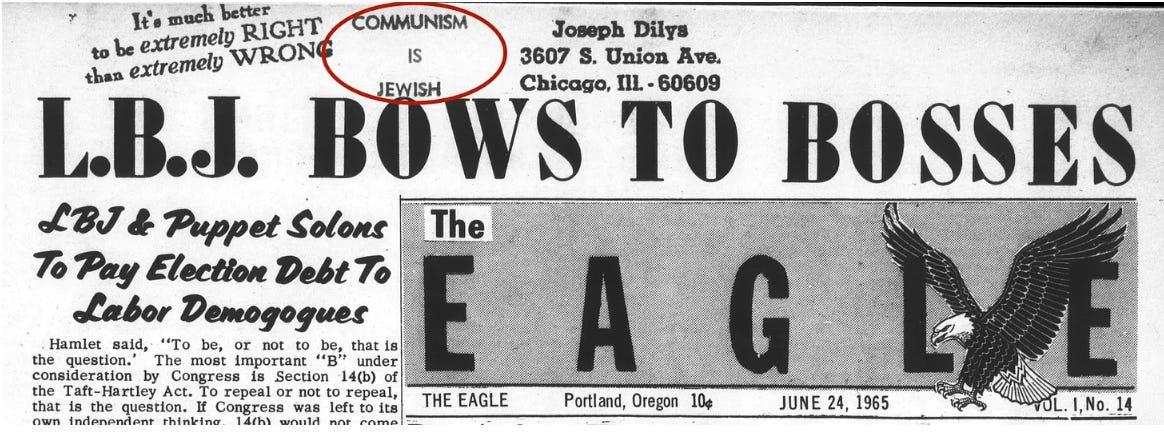


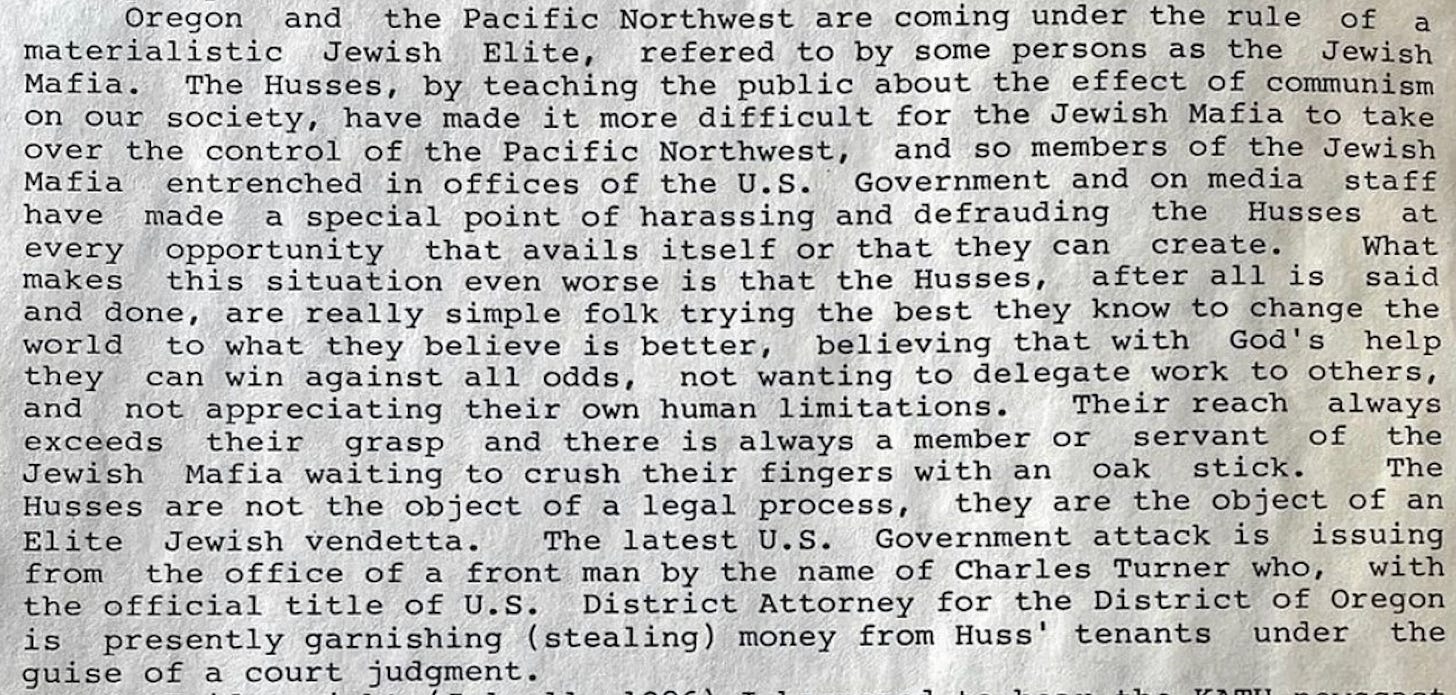

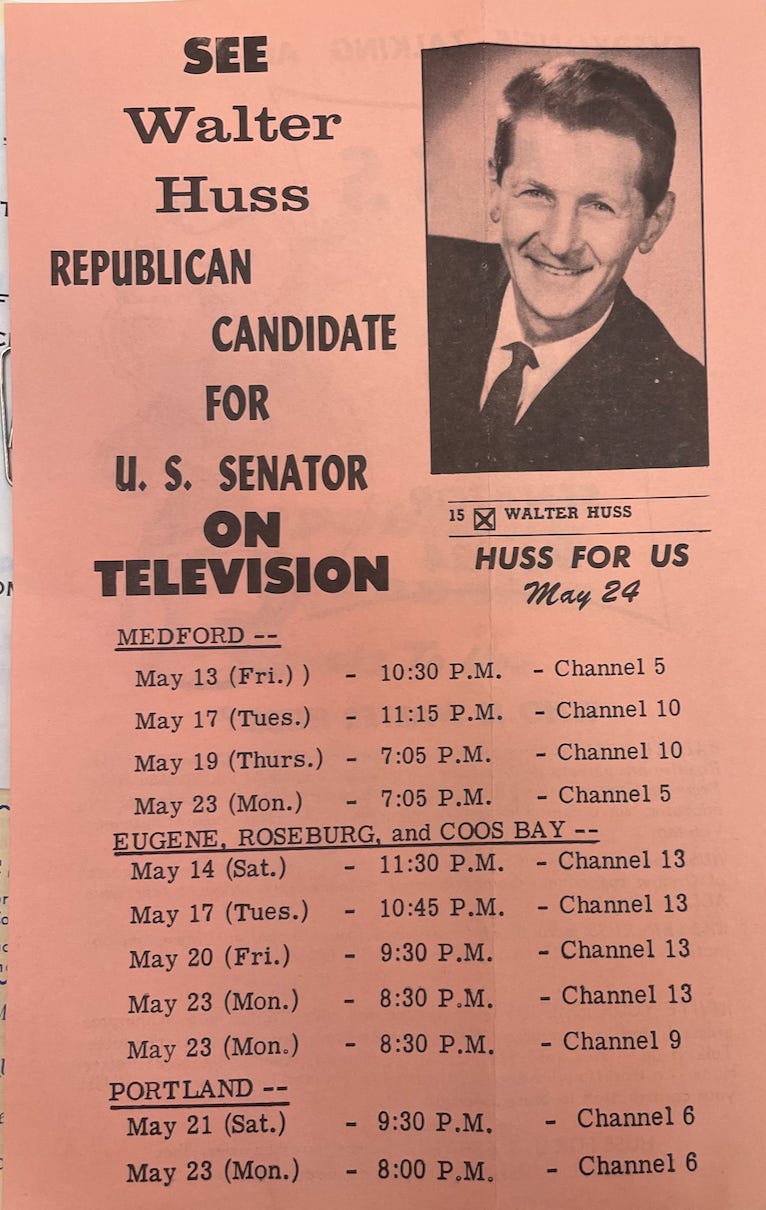
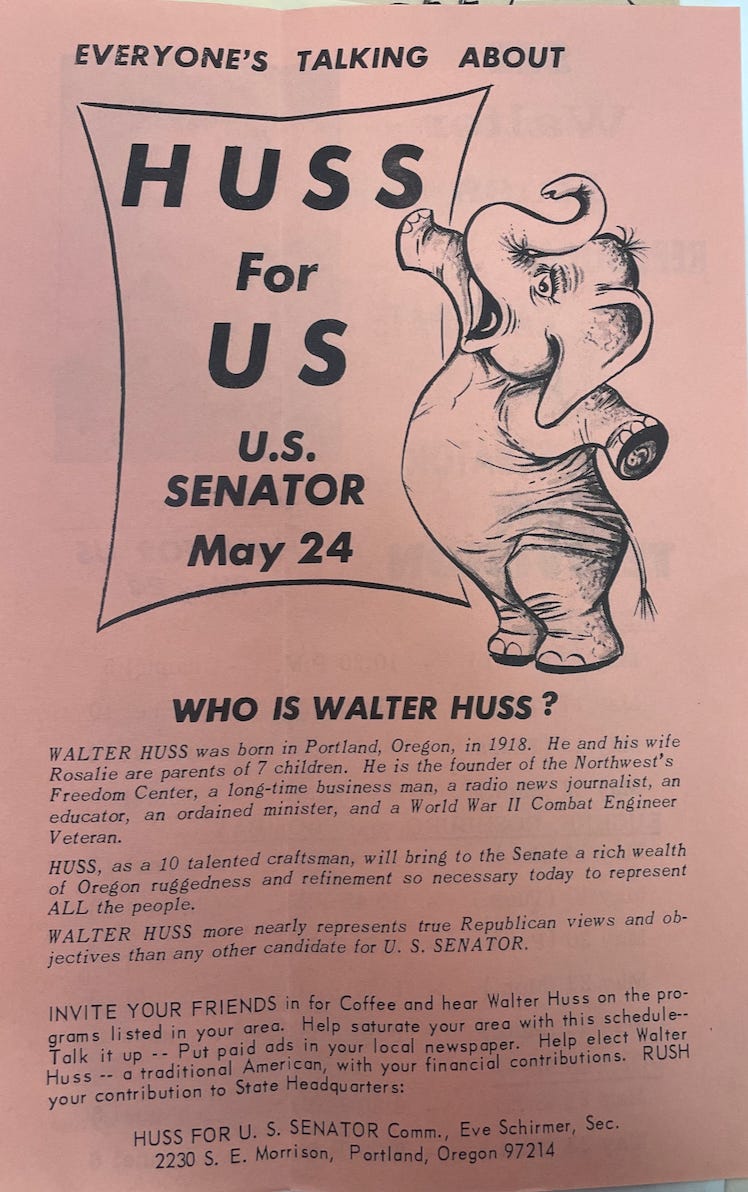
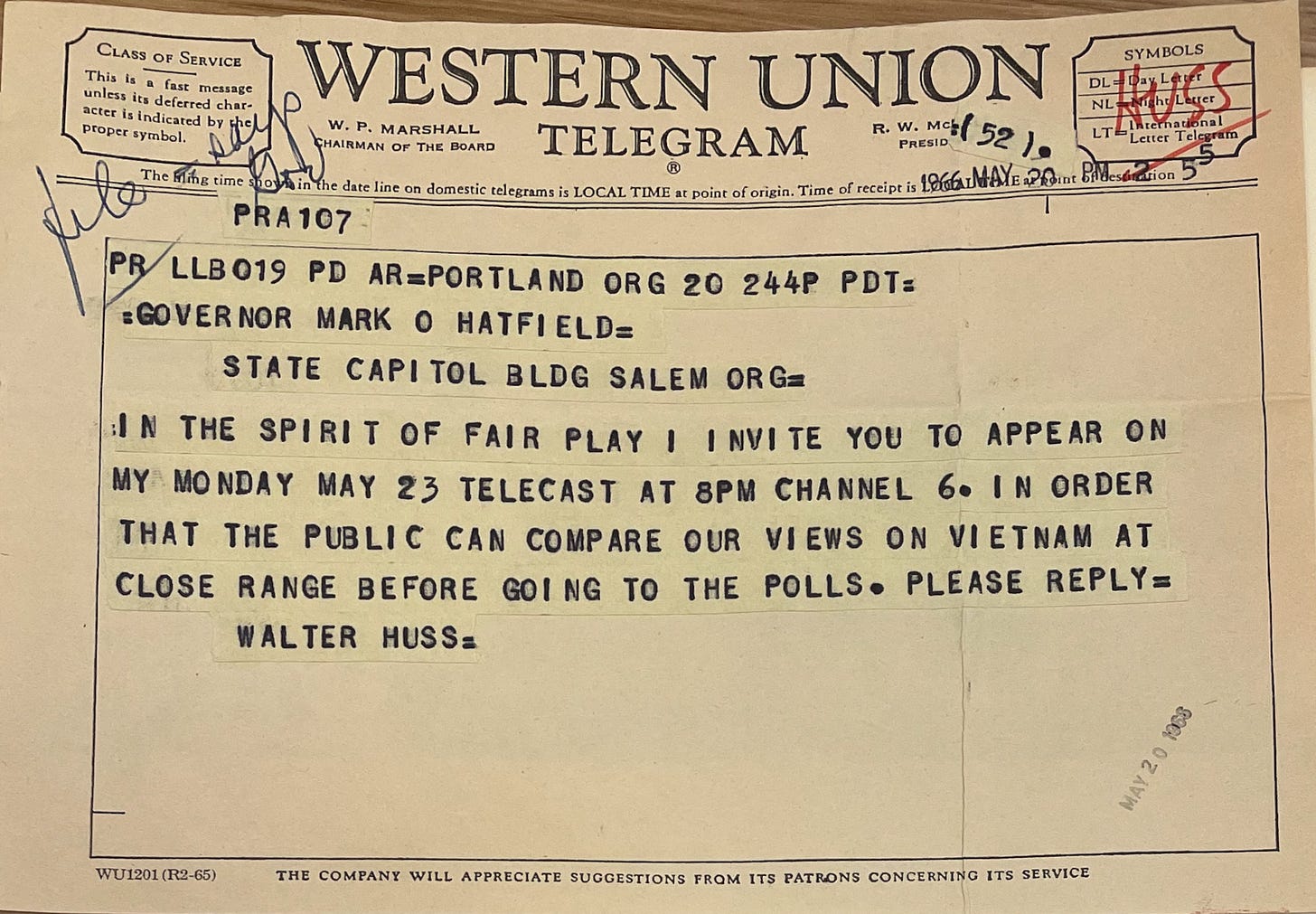



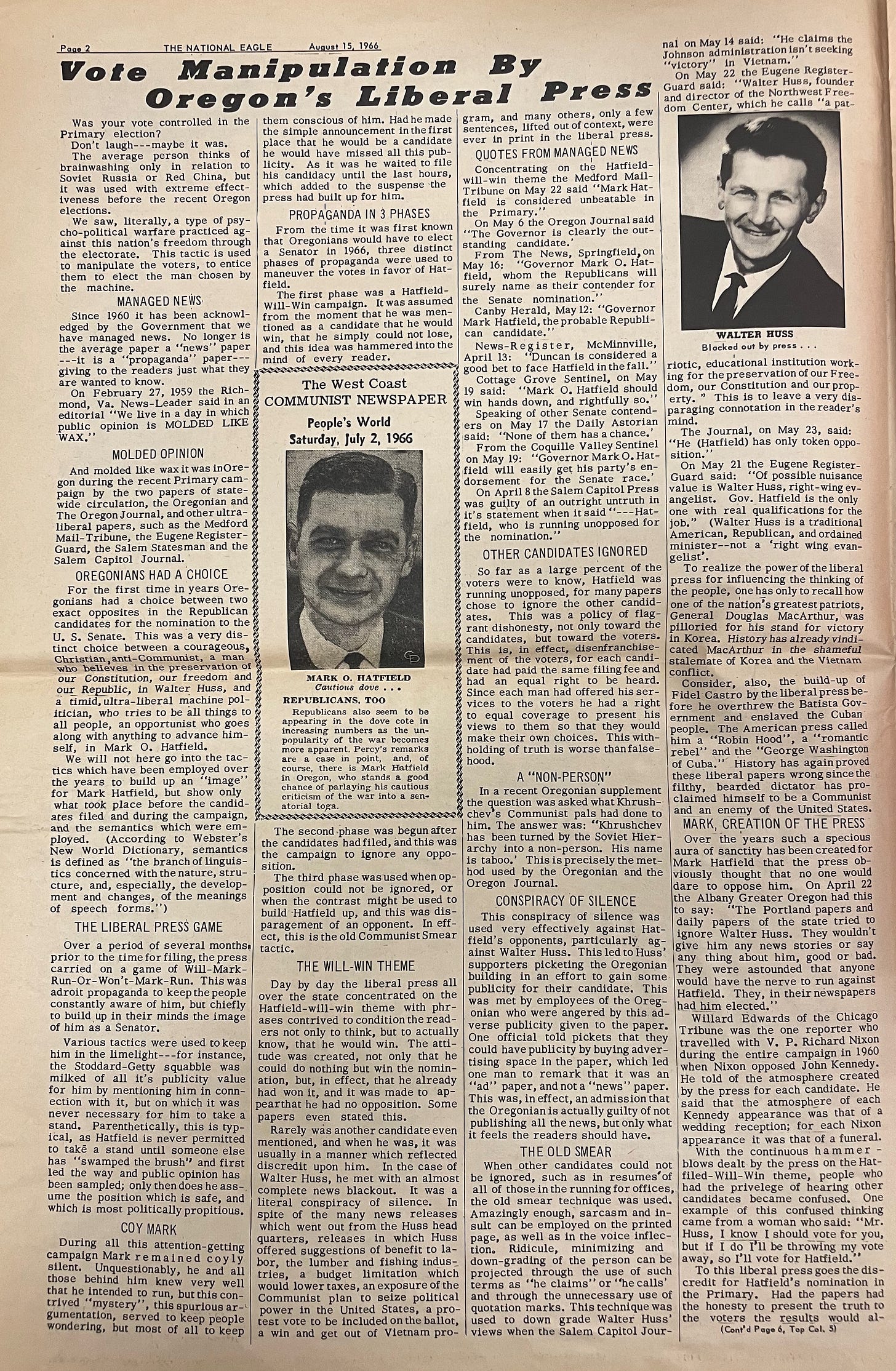
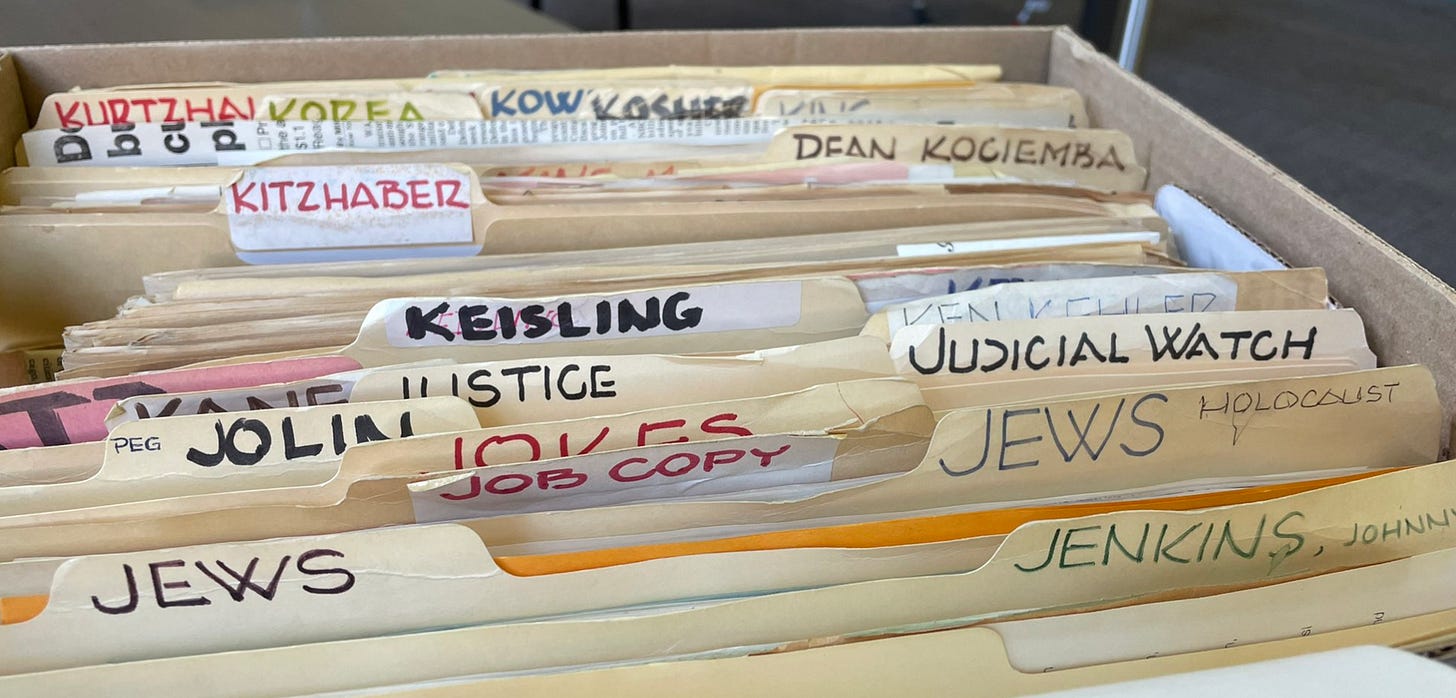

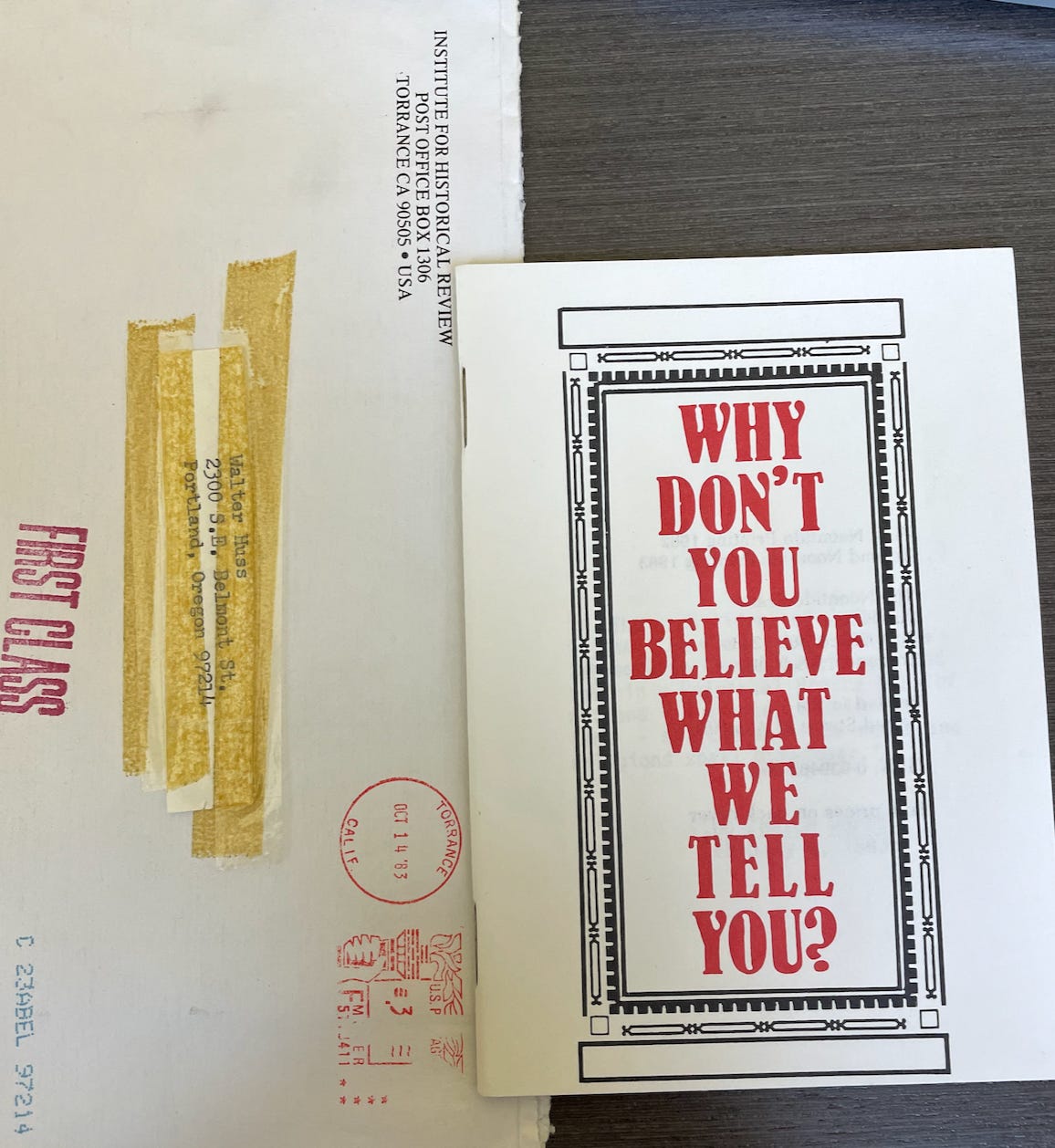
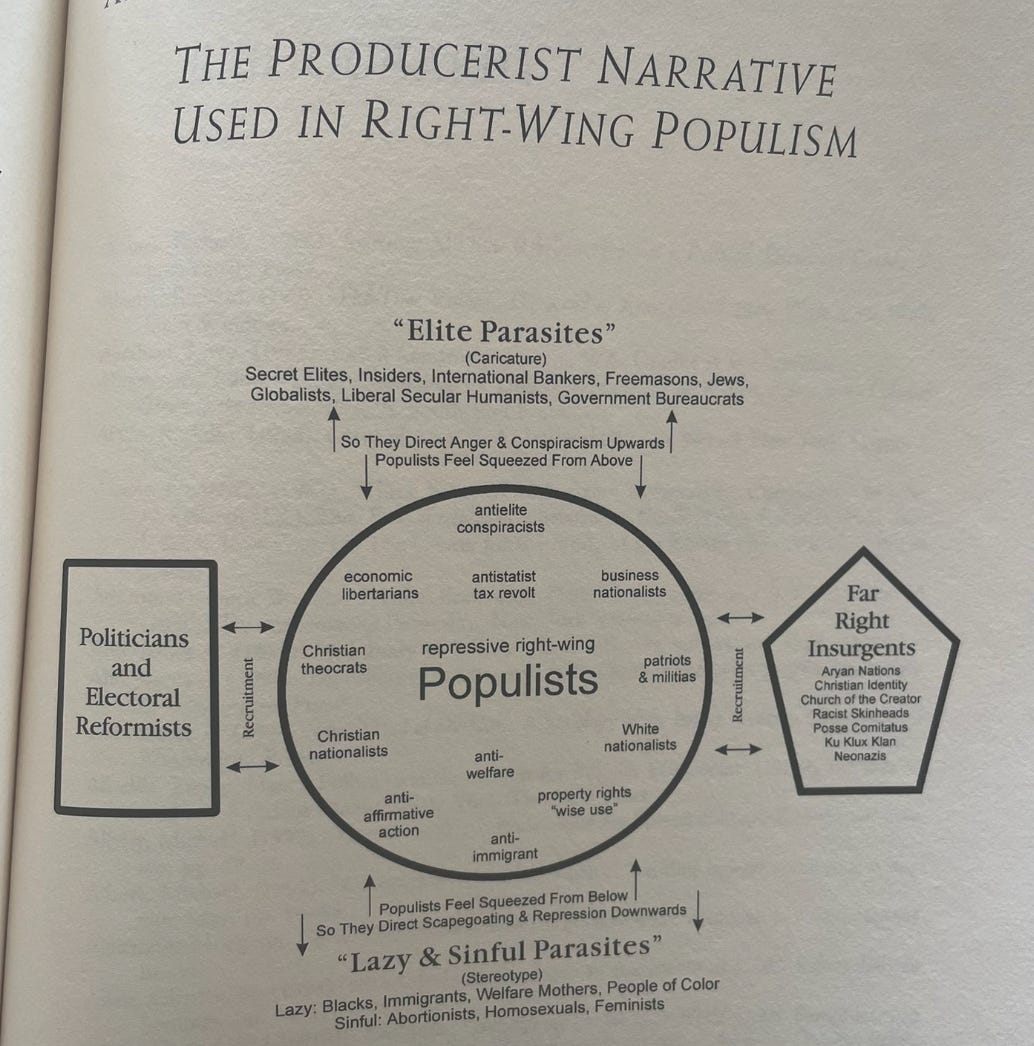
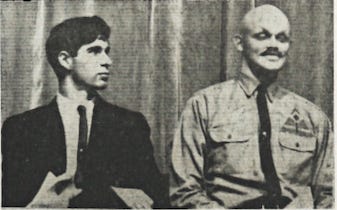
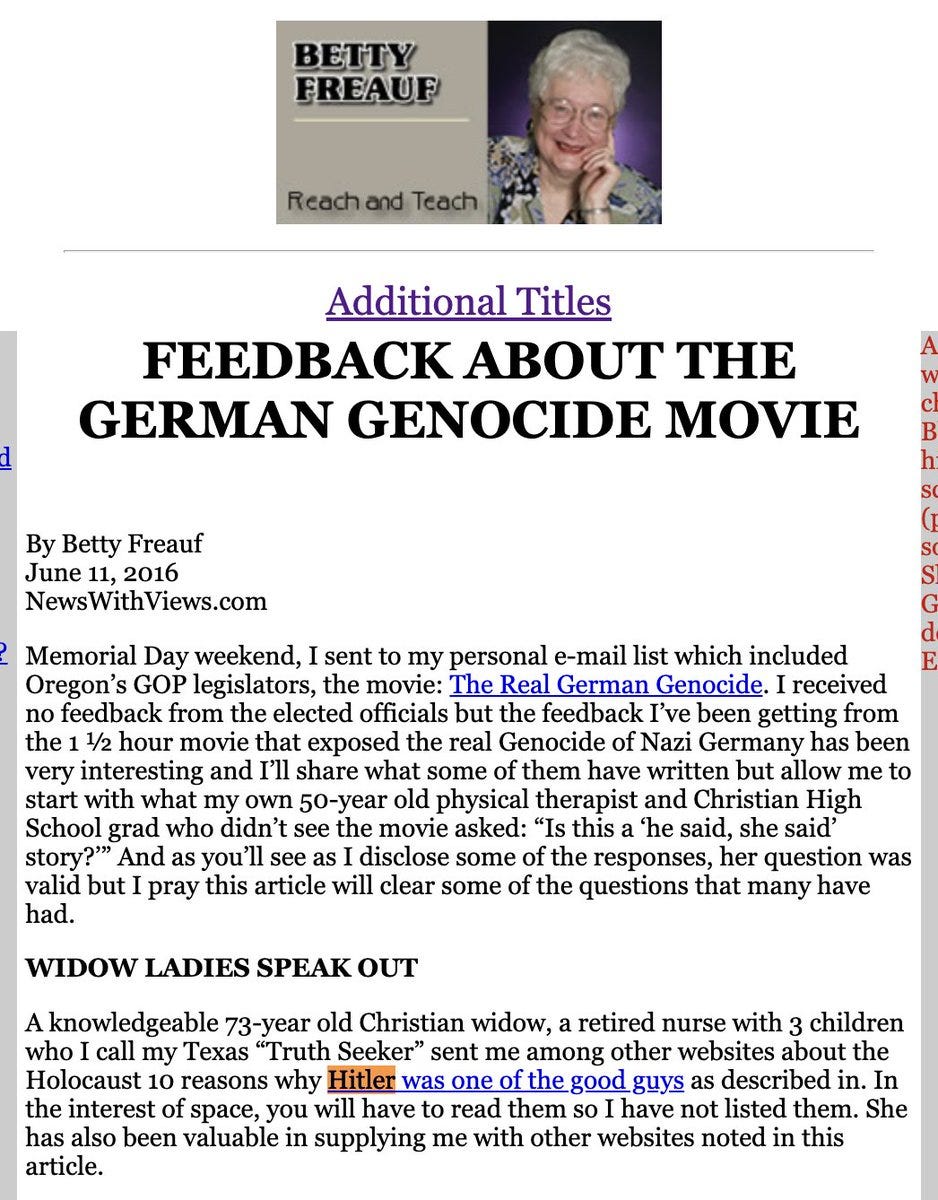
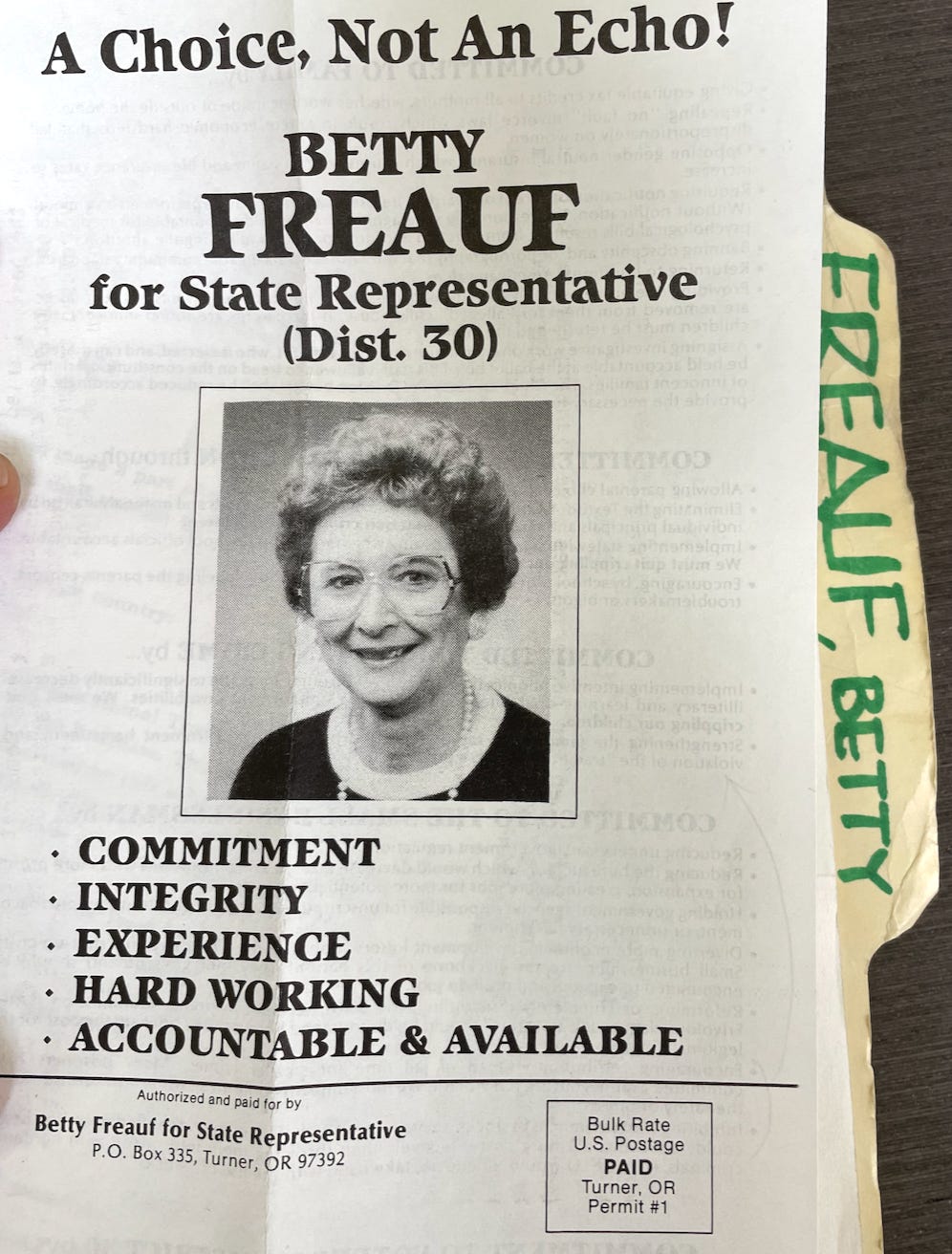
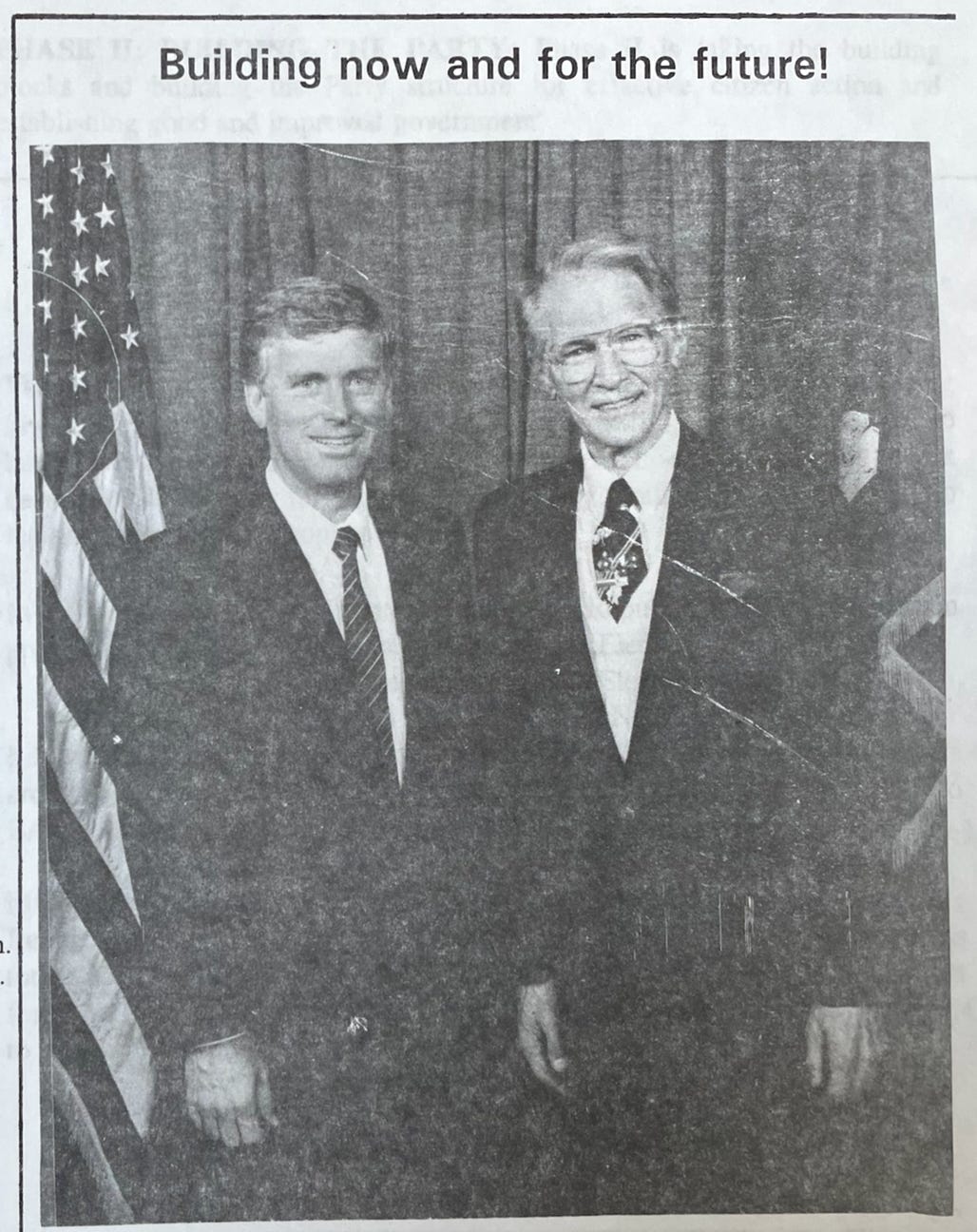

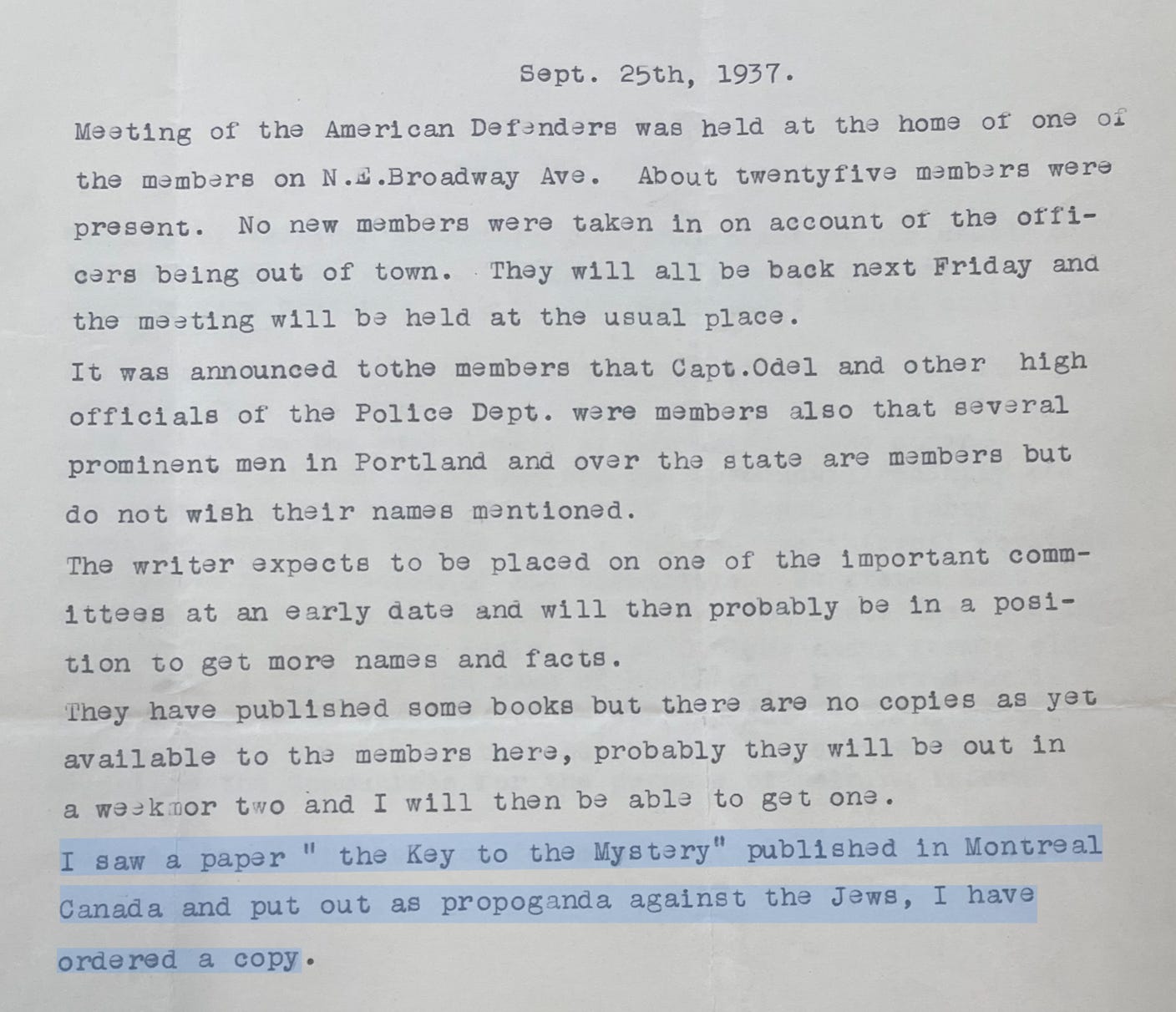
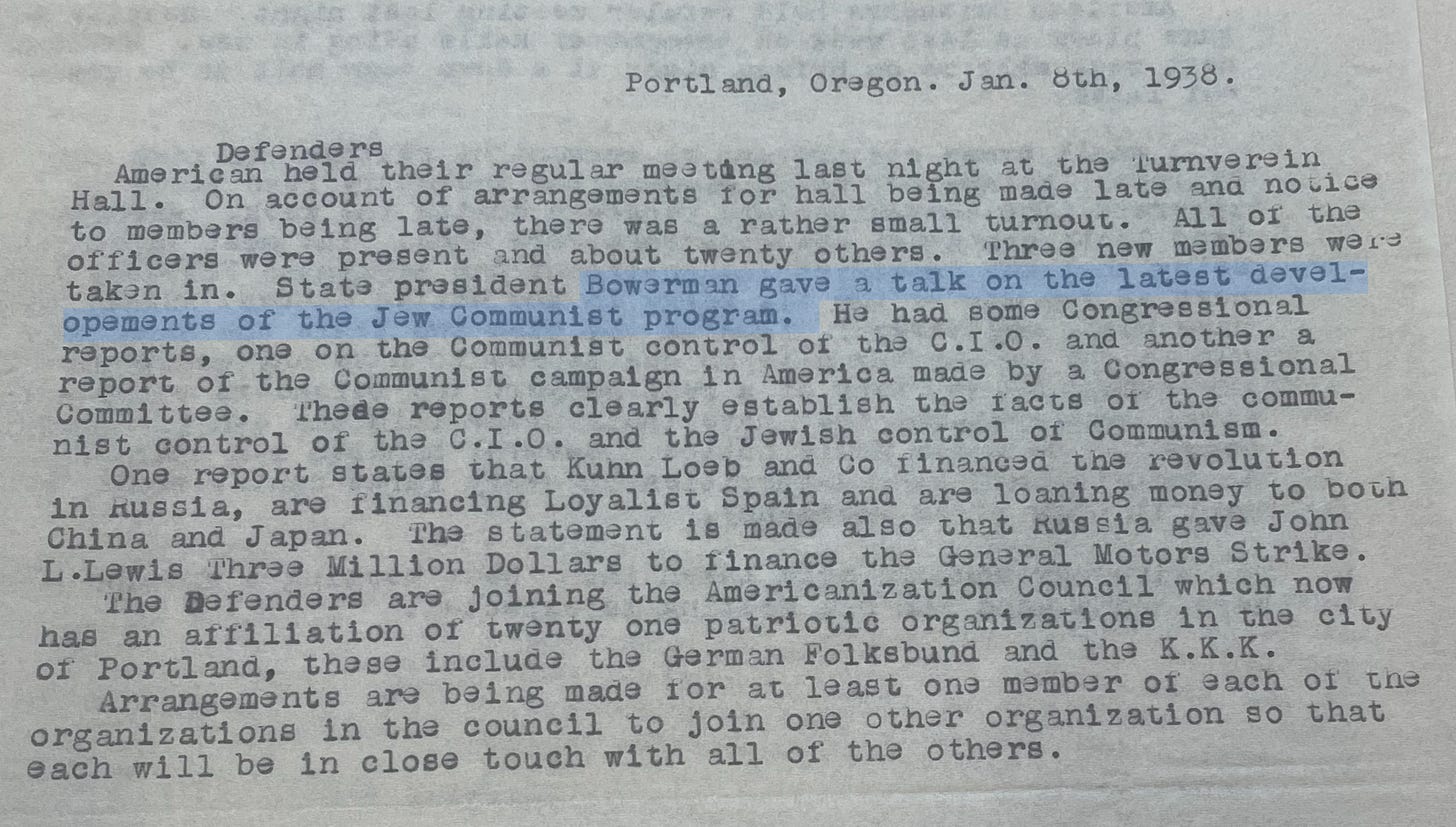






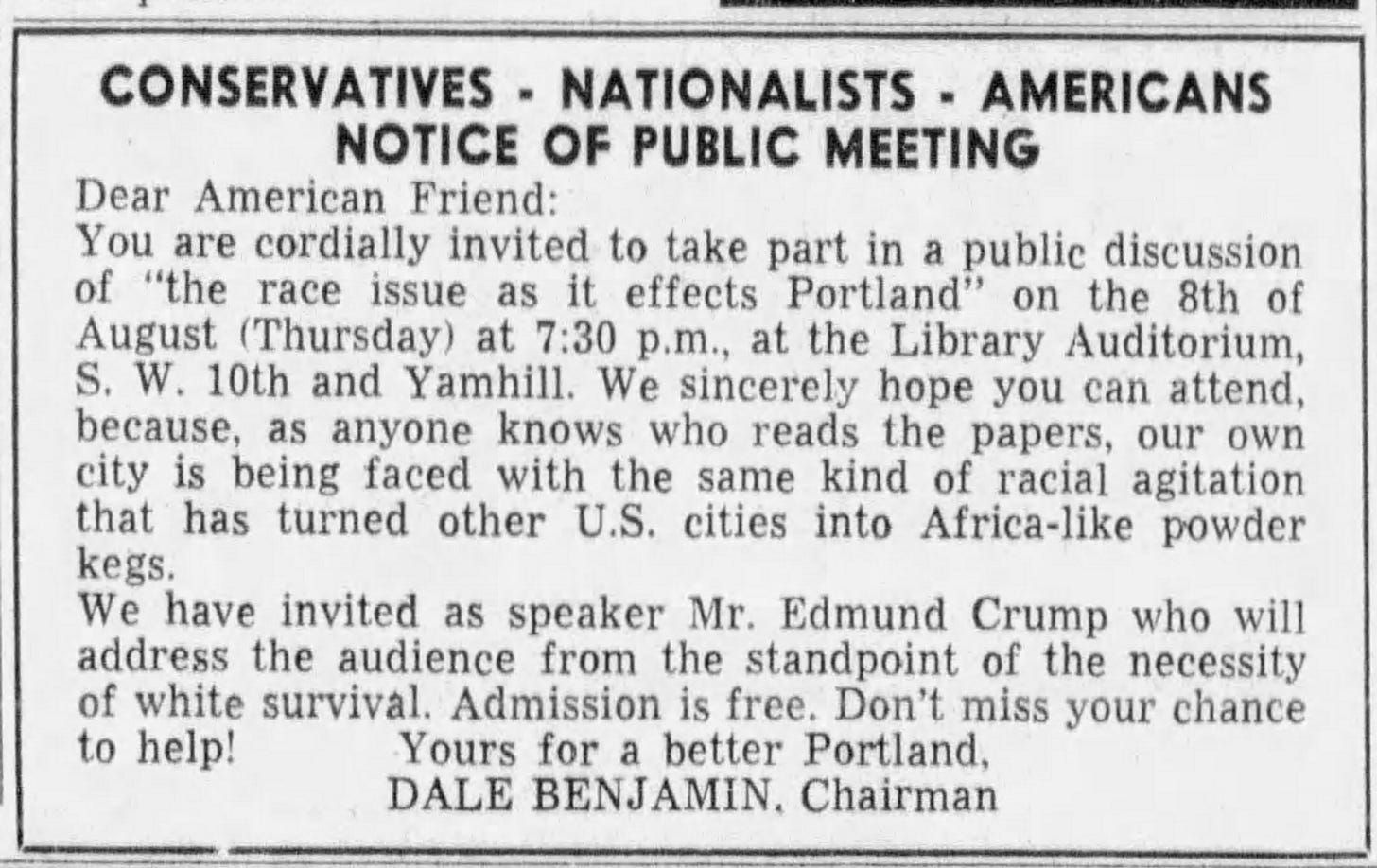
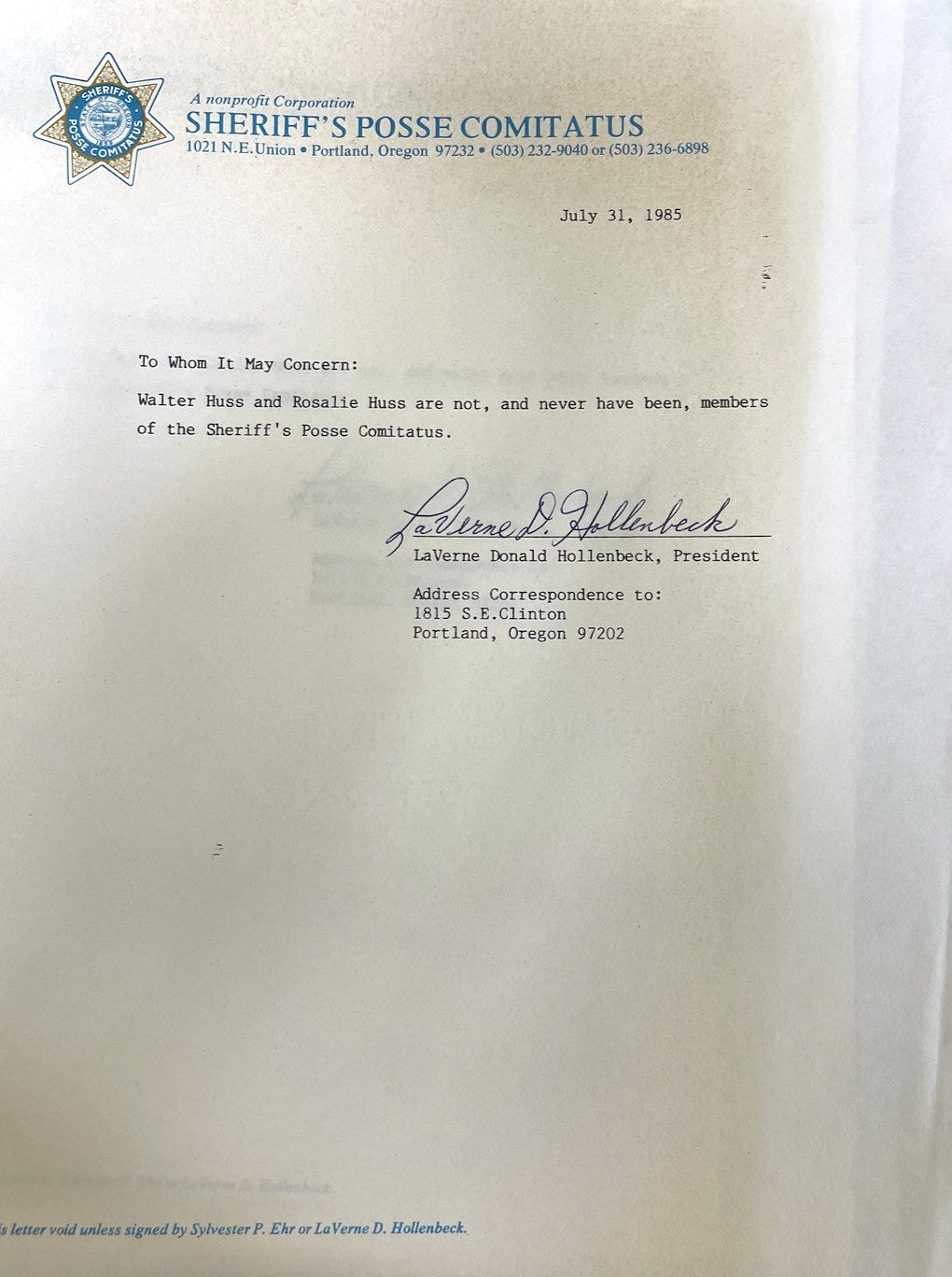
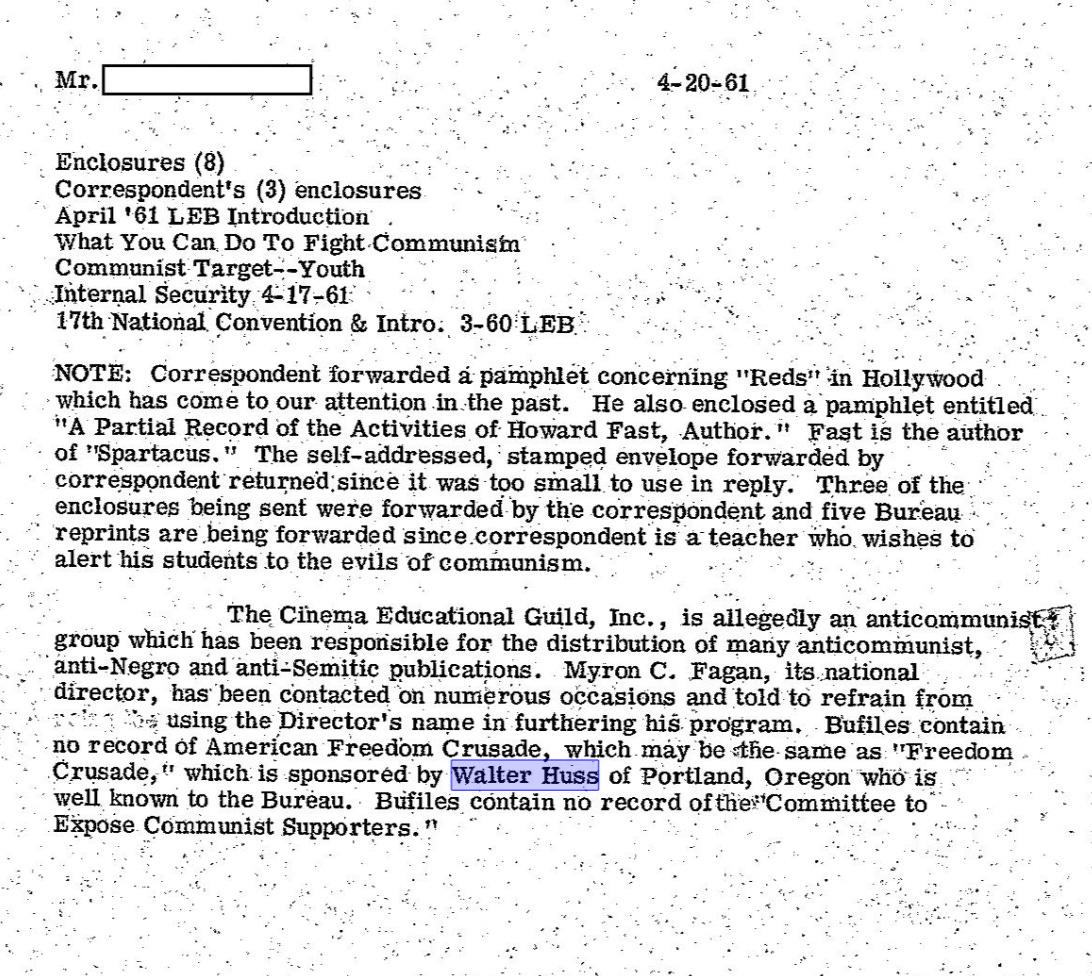
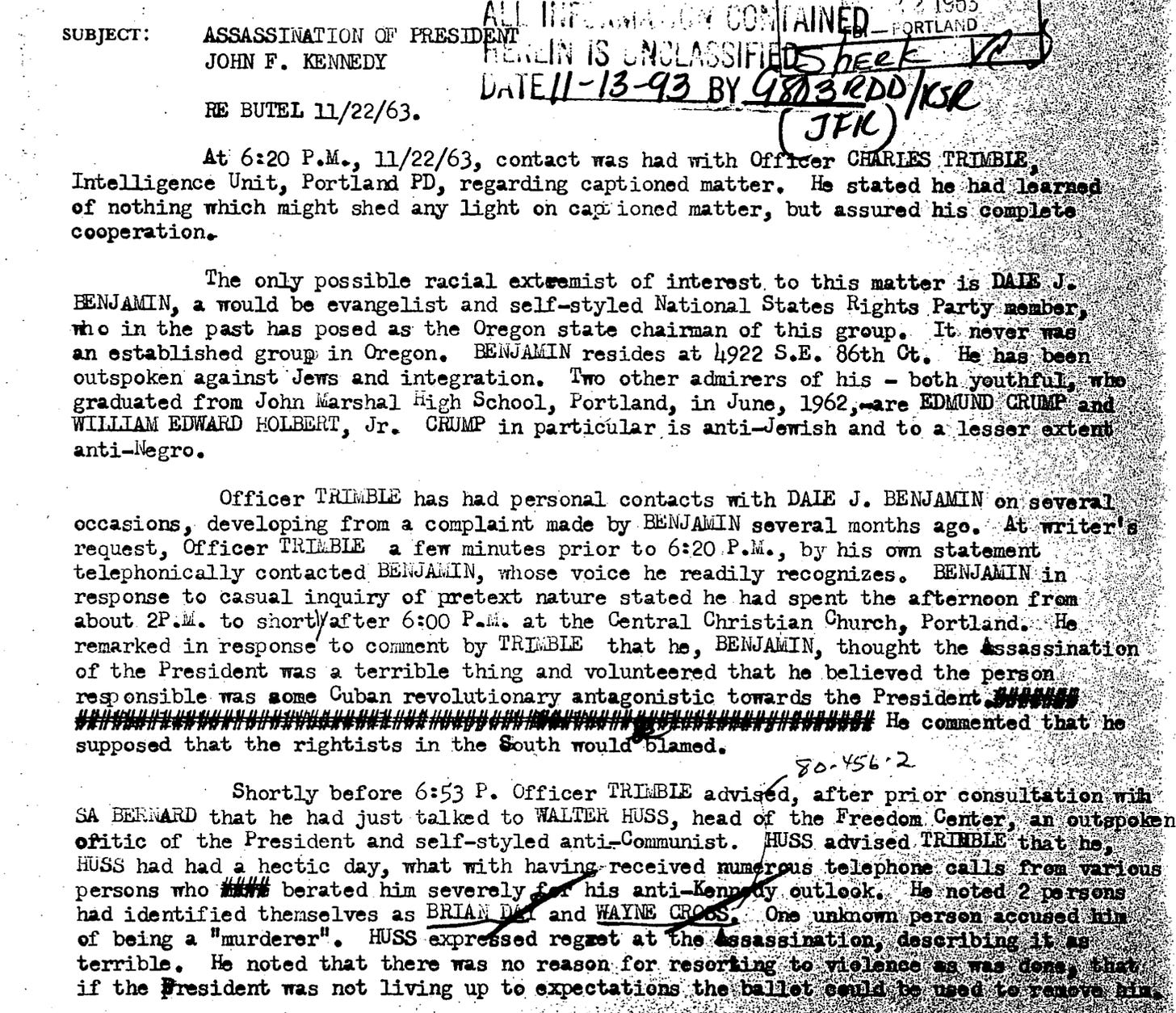
A very convincing argument about the trajectory of Huss and his compatriots. I’ve always believed that mockery and humor are a good response to bigots but perhaps it just punts the problem down the field.
You've made the case for applying "fascist" to Walter Huss quite well here. Being as you say a parsimonious sort, I like to use the word "reactionary" for those fellow-travellers that don't quite (or at least don't obviously) fall directly in the "fascist" bucket. I only mention this because it's absent from your list at the end, despite being quite useful and capturing some aspects of the general framework being described that aren't covered by "authoritarian" or "bigoted".